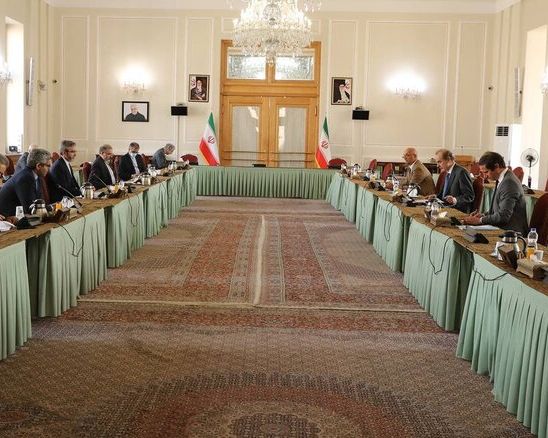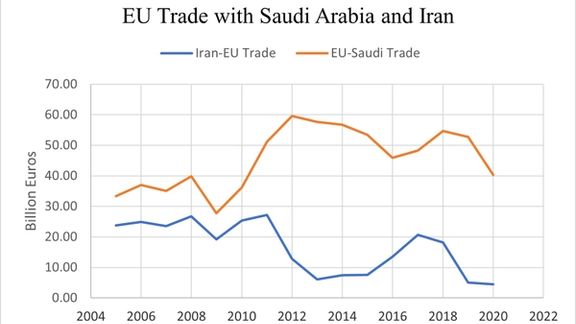The Future Of Iran-EU Trade Is Not Bright

Enrique Mora, the EU envoy coordinating the Iran nuclear talks traveled to Tehran recently in an attempt to convince the regime to return to the Vienna process.

Enrique Mora, the EU envoy coordinating the Iran nuclear talks traveled to Tehran recently in an attempt to convince the regime to return to the Vienna process.
The EU invested considerable political and diplomatic capital in the long process that led to the 2015 accord, formally known as the Joint Comprehensive Plan of Action (JCPOA). EU leaders had tried hard to convince former President Donald Trump not to abrogate the deal, and they have again invested considerable effort, since Joe Biden’s election, to serve as a middleman between Tehran and Washington. All of this diplomacy invites an economic question: What can the EU expect to gain if trade and investment become possible in Iran with the lifting of US sanctions?
The history of Iran-EU trade over the last 15 years shows a downward trend, with a high degree of correlation with the severity of sanctions. When US-initiated secondary sanctions are in place, whether multilateral or unilateral, they quickly affect Iran-EU trade. EU states opposed the Trump administration’s unilateral maximum pressure strategy, but Trump’s sanctions had the same impact on Iran-EU trade as multilateral sanctions did prior to the JCPOA.
In no small part, Iran-EU trade is so sensitive to sancitons because the EU can quickly replace Iran with other trade partners, while Iran can not do likewise. In 2013, at the height of the Obama administration’s sanctions campaign against Iran, EU imports from Iran dropped to 751 million euros from their zenith of 17 billion euros in 2011.
In 2019, the first full year that Trump’s maximum pressure strategy was in place, EU imports from Iran slid to 680 million euros, down from 9 billion euros in 2018. EU exports, while reduced due to US sanctions, have shown less volatility. The EU’s 2013 exports plummeted to 5.3 billion euros from their high of 11 billion euros in 2010. These exports went back up to 11 billion euros in 2017 while the JCPOA was in effect, but in 2020 descended to 3.7 billion euros. Non-Iranian trade partners filled the gaps.

By contrast, trade between the EU and Saudi Arabia, Tehran’s chief rival in the Persian Gulf, benefits from diplomatic stability. Since 2005, EU-Saudi trade has enjoyed a general upward trajectory, even though it is sensitive to volatile markets for oil. However, the Saudis have managed to expand their non-crude exports to the EU. In 2020, 7.2 billion euros — 46 percent of Riyadh’s exports to the EU — were from non-crude oil, up from 3.84 billion euro in 2005.

The greater volatility of EU imports from Iran stems from the impact of sanctions on the import of crude oil. Iran’s non-crude exports to the EU are neither considerable nor growing. They still have not returned to their 2007 level of 1.7 billion euros, and in 2020 were slightly above 600 million euros.

European governments opposed Trump’s unilateral sanctions and tried to convince European companies to trade with Iran. However, the private sector defied Brussels and complied with Washington’s sanctions. Despite loose enforcement of US sanctions by the Biden administration, the data for the first seven months of 2021 show no significant increase in trade between the EU countries and Iran. During this time period, EU’s imports from Iran rose to 480 million euros, slightly higher than 440 million euros during the same period last year, while its exports dropped from 2.21 billion euros to 2.11 billion.
The future of negotiations between Iran and the United States is not promising. The regime is stalling negotiations in order to expand its nuclear program with impunity. Tehran may even develop a nuclear weapon while Biden is in the White House. If Iran goes nuclear, trade with the EU will likely take a dive nearly to zero. It is not clear how much longer Iran can engage in bad-faith negotiations without triggering a meaningful reaction by the Europeans. In the absence of some kind of deal, Iran-EU trade will gradually shrink more. Iran could lose its European market for a long period of time — if not permanently — and the same can happen to European exports to Iran.
Despite its hesitation to rejoing the JCPOA, Iran may decide to accepta “less-for-less” agreement, whereby Tehran would make limited concessions on its nuclear program in exchange for limited U.S. sanctions relief. In so doing, Tehran can keep its nuclear options open until after the 2024 presidential elections in the United States. However, if such a deal resembles the November 2013 interim agreement that preceded the JCPOA, formally known as the Joint Plan of Action (JPOA), Iran-EU trade will improve slightly but is unlikely to rebound fully. The key beneficiaries of a “less-for-less” deal would be Chinese companies, whose currently illicit trade with Iran could come out of the shadows.
After the JCPOA’s implementation, Europe’s imports of Iranian oil — in terms of volume, not value — went back to their pre-2012 level by 2017, even though their value was smaller due to lower oil prices. That quick reversal, however, may not be on the menu this time, at least before 2024, because of the increased political risk of doing business with Iran. If the JCPOA is revived, a complete restoration of oil trade between the EU and Iran could develop, but would still face obstacles.
First, there is a real risk of a Republican comeback in 2024. As Trump demonstrated, the prospect of a Republican president tearing apart a deal made by a Democratic predecessor is real. If a Republican administration decides to revive the maximum pressure campaign in 2025, the process of leaving the JCPOA will probably happen much faster, since the year-and-a-half political debate that preceded Trump’s withdrawal in 2018 is unlikely to reoccur. Consequently, large multinational firms may decide to take their time to reenter Iran, especially if Tehran and Washington reach a deal close to the U.S. presidential election.
Second, the government in charge of Iran is not led by the so-called moderate Hassan Rouhani. The current president, Ebrahim Raisi, the butcher of Tehran, is a mass murderer in bed with the Islamic Revolutionary Guard Corps (IRGC) — the regime’s praetorians — and the most radical elements of the Islamist establishment. This reality increase the political risk of doing business with Tehran.
Third, the regime in Tehran may have its own reservations about resuming trade with the EU. Recently, Ayatollah Ali Khamenei, the supreme leader of the Islamic Republic, banned imports of South Korean home appliances — likely as retribution against Seoul for its compliance with U.S. sanctions. Furthermore, over the last decade, European companies left Iran in limbo and failed to adhere to their financial commitments, not once but twice, under U.S. pressure — first in the 2011-2013 sanctions period and then after the maximum pressure in late 2018. The resulting tension between the EU and Iran suggests that even if Iran returns to the nuclear deal, it may not welcome European exporters. Instead, Tehran may decide to prioritize working with Chinese companies or outright ban imports of European goods in specific industries.
The fate of the JCPOA and Tehran’s nuclear program is not clear. As time passes, however, optimism about the resurrection of trade between Iran and EU may become less and less warranted.
The opinions expressed by the author are not necessarily the views of Iran International